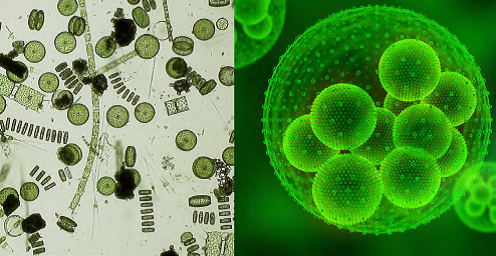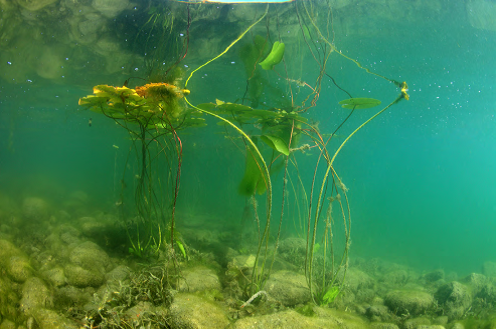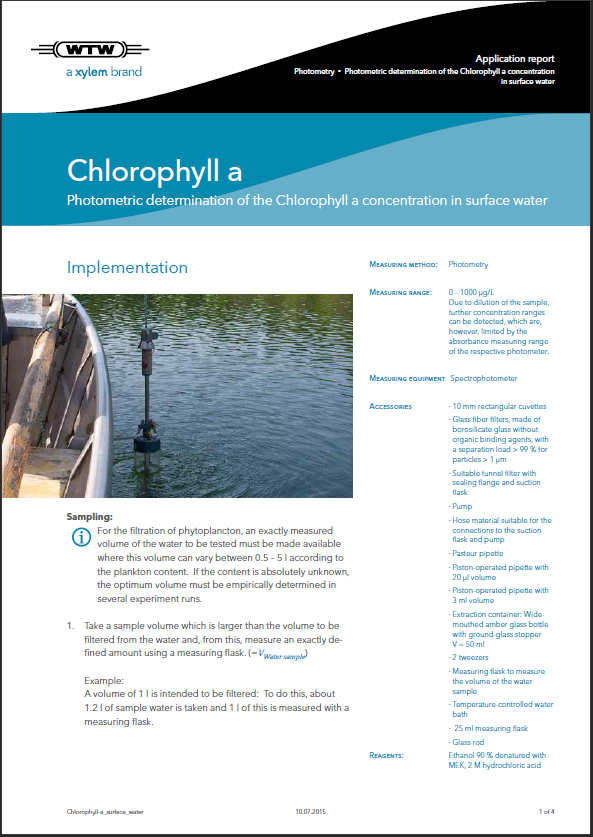
Measuring method:
Photometry
Measuring range:
0 – 1000 μg/L
Due to dilution of the sample, further concentration ranges can be detected, which are, however, limited by the absorbance measuring range of the respective photometer.
Measuring equipment:
Spectrophotometer
Accessories:
- 10 mm rectangular cuvettes
- Glass fiber filters, made of borosilicate glass without organic binding agents, with a separation load > 99 % for particles > 1 µm
- Suitable funnel filter with sealing flange and suction flask
- Pump
- Hose ma terial suitable for the connections to the suction flask and pump
- Pasteur pipette
- Piston-operated pipette with 20 µl volume
- Piston-operated pipette with 3 ml volume
- Extraction container: Wide-mouthed amber glass bottle with ground-glass stopper V = 50 ml
- 2 tweezers
- Measuring flask to measure the volume of the water sample
- Temperature-controlled water bath
- 25 ml measuring flask
- Glass rod
Reagents:
Ethanol 90 % denatured with MEK, 2 M hydrochloric acid
Implementation:
Sampling:
For the filtration of phytoplancton, an exactly measured volume of the water to be tested must be made available where this volume can vary between 0.5 – 5 l according to the plankton content. If the content is absolutely unknown, the optimum volume must be empirically determined in several experiment runs.
1. Take a sample volume which is larger than the volume to be filtered from the water and, from this, measure an exactly de-fined amount using a measuring flask. (=VWater sample)
Example:
A volume of 1 l is intended to be filtered: To do this, about 1.2 l of sample water is taken and 1 l of this is measured with a measuring flask.

Make sure that the temperature of the water sample corresponds to the pre-determined temperature for the content of the measuring flask (printed on the measuring flask), otherwise, adjust the temperature of the sample to the pre-determined temperature.
Filtration:
2. Equip the suction filter with the glass fiber filter and suction the entire measured volume through the filter with negative pressure. Let the suction filter suction dry afterwards for approx. 30 seconds.
Extraction:
3. Heat approx. 20 ml ethanol to approx. 78°C in the water bath.
4. Carefully remove the filter material from the suction filter using tweezers, put it in the extraction container and rip it into tiny pieces inside the container using a second pair of tweezers. If necessary, fold the filter in such a way that the chlorophyll film lies on the inner side for its own protection prior to placing it in the extraction container.
5. Pour the heated ethanol over the filter snippets, close the extraction container and place this in the water bath for approx. 20 minutes. Shake the device several times during this period.
6. Keep the extraction container tightly closed and in the dark over night.
7. Take the liquid out of the extraction container using a pasteur pipette and transfer it to a 25 ml measuring flask. Finally, press the filter fiber against the upper wall of the extraction container, held at a slight angle, sev-eral times with a spatula so that a maximum of extract can be withdrawn.
8. Ensure that the extract, as well as the ethanol used for filling up, are at the predetermined temperature for the content of the measuring flask (printed on the measuring flask). Adjust the temperature of both liquids to the required value if necessary.
9. Now fill the 25 ml (=VExtract) measuring flask up to the mark with ethanol and close it afterwards with a stopper.
The extract obtained is light-sensitive and must be protected from light incidence and measured as soon as possible. The evaporation of the ethanol is prevented by always keeping the measuring flask closed.
If the extract should become cloudy which can lead to the extinction measurement result being falsified, the liquid must be centrifuged. Should there still be turbidity, the mixture of substances must then either be separated by chromatography or turbidity correction of the extinction values must be carried out by the subtraction of the extinction at 750 nm.
For further details, see [1].
Measurement:
The absorption of the base line is carried out with the same ethanol that was used for the extraction.
10. Put 3 ml of extract into a 10 mm rectangular cell using a pipette, measure the extinction at 665 nm and note this value as Ebefore.
If the extinction value here already lies outside of the measuring range of the photometer, the chlorophyll content of the extract must be adapted by altering the extract volume or altering the volume of the water sample to be filtered.
11. Rinse the rectangular cell with ethanol and dry it with a clean cellulose cloth.
12. Put 3 ml of the extract into the rinsed cell, add 20 µl of 2M hydrochloric acid, briefly mix it with a glass rod and wait approx. 10 minutes.
13. Now measure the extinction of the sample at 665 nm and note the value as Eafter.

Calculation::
The chlorophyll a content of the sample is calculated according to the following formula:
CChlorophyll-a = 29,6 x (Ebefor - Eafter) x (Vextract / Vwater probe x d)
The individual symbols in the formula have the following meaning :
| 29,6 |
The factor is calculated from (R / R - 1) x (103 / a) [μg cm |
L-1]
with R = 1,7 (acid quotient of pure Chlorophyll a / empirical value),
α = 82 L μg-1 cm-1 (specific extinction coefficient of Chlorophyll a in 90 % ethanol);
103 takes into account the different units of Extrac Vextract [mL] und Vwater probe [L]. |
| Evor |
= extinction before the addition of acid |
| Enach |
= extinction after the addition of acid |
| VExtrakt |
= Volume of extract in the unit ml (here 25 mL) |
| VWasserprobe |
= volume of the water sample measured with a measuring flask in the unit L. |
| d |
= thickness of the measuring cell in the unit cm (here 1 cm) |
Informationen:
Bibliography:
[1] DIN 38412, Determination of chlorophyll a in surface water
Notes:
The information contained in our application reports is only intended as a basic description of how to proceed when using our measure-ment systems. In isolated instances or if there are special general con-ditions on the user side, excep-tional properties of the respec-tive sample can, however, lead to a change in the execution of the pro-cedure or require supplementary measures and may, in rare cases, lead to a described procedure being unsuitable for the intended application.
In addition, exceptional proper-ties of the respective sample such as special general conditions can also lead to different measurement results.
The application reports have been prepared with the greatest possible care. Nevertheless, no responsibil-ity can be accepted for the correct-ness of this information.
The current version of our general terms of business applies.
Please note that the amounts must be entered in the required unit as otherwise this would lead to incorrect results.
Notes:
Some photometers allow the independent calculation of the con-centration value after programming of the method. If necessary, look this up in the operating manual of your photometer.
Here you can download the whole article as a PDF:
